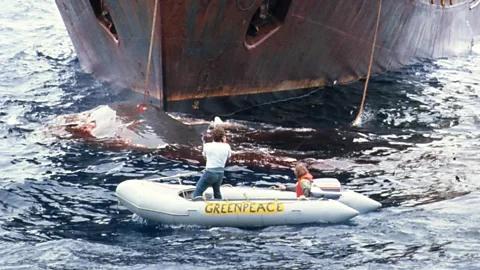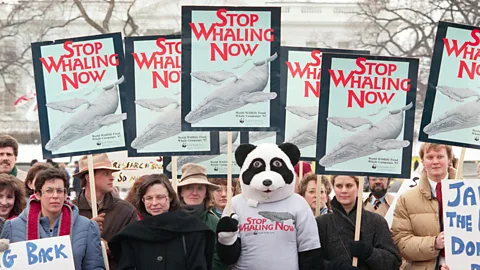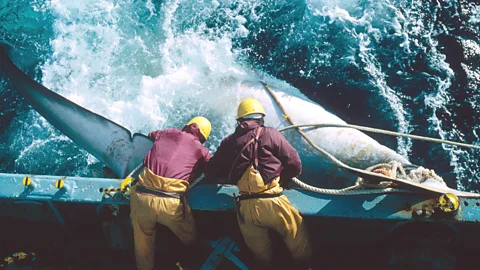The 'mind bomb' photos that led to a global whaling ban
 Rex Weyler
Rex WeylerIn the 1970s, a small group of Greenpeace activists had a unique idea for how they could put an end to commercial whaling.

A large Soviet vessel, harpoon gun poised to fire, looms over a whale immediately below the bow, the animal's large gaping wound oozing blood into the cold Pacific Ocean.
It's an image that changed the world and marked the beginning of Greenpeace's "mind bomb" campaign, says Rex Weyler, the photographer behind the 1975 photo (scroll down to see that iconic shot below).
Weyler was among the early members of Greenpeace who met in Canada during the 1970s. Many of them, including Weyler, had left the US to escape being drafted for the Vietnamese War. "It's so hard to imagine today but at that time there was no ecology movement," he remembers. "There was the peace movement, the women's movement, the civil rights movement, and we felt there needed to be a conservation movement on the same scale as those."
Weyler found out about the plight of the whales through a Canadian author doing a book tour at the time.
"At the time people thought whaling was this Moby Dick image. Little men in these little boats facing these giant whales. The whales were Goliath," he says. "We wanted to flip that Goliath image around because by the 1970s, whalers had giant boats with fast diesel motors and exploding 250lb (113kg) harpoons. And we wanted to capture that image."
 Rex Weyler
Rex WeylerWhaling peaked in the 1960s, with approximately 80,000 whales being hunted every year. Hunting technology had advanced and whalers had harpoons and ships that could outrun whales.
Despite various whaling protection measures being introduced, including the International Agreement of the Regulation of Whaling in 1937, some countries, such as Russia and Japan, ignored them and caught whales illegally. Between 1900 and 1999, an estimated 2.9 million large whales were caught and killed by the industrial whaling operations, although the actual numbers are believed to be much higher.
"Already in the 1960s, the rapid decline of whale stocks worldwide was clear," says Árni Finnsson, chair of the Iceland Nature Conservation Association and a lifelong ocean activistwho worked for Greenpeace Sweden in the early 1990s. "Although the hunt for blue whales in the North Atlantic was banned by the International Whaling Commission (IWC) in 1954, the management structure was weak and the excessive whaling continued."
In 1972, Finnsson explains, the UN Conference on the Human Environment called for a 10-year moratorium on whaling. "The IWC disregarded this call by the international community and Greenpeace took action, at sea, in order to protest this ruthless exploitation, notably against Soviet whaling vessels in the Pacific," he says.
The newly formed Greenpeace had spent two or three years preparing the boat and a crew. "In 1975 we set out in little Zodiac inflatable boats to find a whaling fleet," Weyler says. "The whole idea of our campaigns at that time was media. So we decided we were going to blockade the whaling boats, and get between the whales and the harpoon. So off we go, looking for the whalers, and we found the Russian whaling fleet off the coast of California."
 Getty Images
Getty ImagesMany of the group had some experience with the media and they knew they needed striking photos for this confrontation to become a global news story. They soon termed these kinds of campaigns "mind bombs" – an idea that would become the cornerstone of Greenpeace campaigning, Weyler explains. The mind bomb, something dreamt up by Bob Hunter, another early member of Greenpeace, revolved around the media being a global delivery system for ideas. Revolution wasn't an armed struggle, according to Hunter, it was a communications struggle, where mind bombs were the weapons – rather than actual bombs.
"We knew we had to take photos, we knew it had to be dramatic. That was the whole purpose of making this dramatic gesture – to record it so this would become a news story and we could talk about the plight of the world's whales," says Weyler.
But it wasn't easy. "We all had to learn how to take photographs and shoot films from a small moving boat on a choppy ocean," he says. "We stood at the bow of the Zodiac with a line around our waist to secure us. We could lean back against that line and kind of become our own tripod and absorb the movement of the boat so we could hold the camera steady."
More like this:
Catching the whales on camera was the biggest challenge. "They were being chased by harpoon boats so they would rise to the surface, breathe out, breathe in, and dive again." There wasn't much to photograph, Weyler adds, until the whales had been hit by a harpoon.
"My awareness was mostly focused on exposure, shutter speed, those things," he says. It was only after he'd put down his camera that what he had witnessed hit him.
"It was devastating. We had never seen anything like it. We saw [the whaling boats] harpoon whales, there was massive amounts of blood in the water, and whales flapping and splashing as they struggled and then died.
"We were ripped up inside. I recall being on the deck of the main Greenpeace boat and looking out across the water and feeling gut-wrenched. Devastated at the reality of what we had just witnessed."
When the crew landed at a port in San Francisco, the dock was swamped with media, Weyler recalls. "We weren't prepared for that kind of response. Everybody wanted the images."
Weyler remembers waking up early the next morning and going to a newsstand to see if his image had made the papers. "I was so excited because I was wondering if we'd made it. And I walked the streets until I found a newsstand, and the photograph was on the front page of virtually every newspaper. It was a stunning moment. It had been our dream."
 Getty Images
Getty ImagesFor Weyler, the point of the photographs was to show protestors "not just standing up for human rights or peace" but for other species. "Change comes when the population insists on it," he says. "And we were attempting to inspire the population to rise up and to say to the government, 'We have to preserve these species.' I feel that in many ways this particular image really helped create the global climate movement we have today."
After Greenpeace's whaling campaign, a moratorium on commercial whaling was finally implemented by the International Whaling Committee in 1982, followed by a ban in 1985. As a result, some of the bigger whaling species, such as humpbacks, have made a remarkable recovery – to 93% of their pre-industrial-hunting populations.
Commercial whaling does still happen, though – namely by Iceland, Norway and Japan.
"Greenpeace's actions inspired the public," Finnsson says, "and in 1982 Greenpeace and other non-profits were instrumental in achieving a moratorium on commercial whaling, which still stands."
--
For essential climate news and hopeful developments to your inbox, sign up to the Future Earth newsletter, while The Essential List delivers a handpicked selection of features and insights twice a week.
